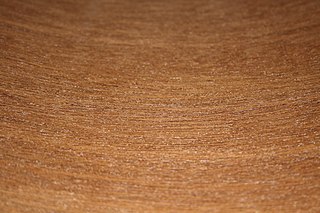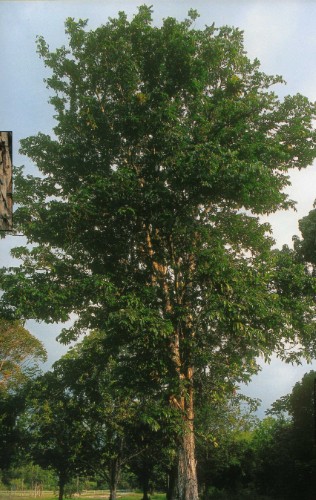
Agarwood, aloeswood, eaglewood,gharuwood or the Wood of Gods, most commonly referred to as oud or oudh, is a fragrant, dark and resinous wood used in incense, perfume, and small hand carvings. It is formed in the heartwood of Aquilaria trees after they become infected with a type of Phialophora mold, P. parasitica. The tree defensively secretes a resin to combat the fungal infestation. Prior to becoming infected, the heartwood is mostly lacking in scent, and is relatively light and pale in coloration. However, as the infection advances, and the tree produces its fragrant resin as a final option of defense, the heartwood becomes very dense, dark, and saturated with resin. This product is harvested, and most famously referred to in cosmetics under the scent names of oud, oodh or aguru; however, it is also called aloes, agar, as well as gaharu or jinko. With thousands of years of known use, and valued across Christian, Hindu and Muslim communities, oud is prized in Middle Eastern and South Asian cultures for its distinctive fragrance, utilized in colognes, incense and perfumes.

Entandrophragma cylindricum is a tree of the genus Entandrophragma of the family Meliaceae. It is commonly known as sapele or sapelli or sapele mahogany, as well as aboudikro, assi, and muyovu.

Durio kutejensis, commonly known as durian pulu, durian merah, nyekak, Pakan, Kuluk, or lai, is a primary rainforest substorey fruit tree from Borneo.

Intsia bijuga, commonly known as Borneo teak, Johnstone River teak, Kwila, Moluccan ironwood, Pacific teak, scrub mahogany and vesi, is a species of flowering tree in the family Fabaceae, native to the Indo-Pacific. It ranges from Tanzania and Madagascar east through India and Queensland, Australia, Papua New Guinea to the Pacific islands of Fiji and Samoa. It grows to around 50 metres tall with a highly buttressed trunk. It inhabits mangrove forests. Intsia bijuga differ from Intsia palembanica in the number of leaflets that make up their compound leaves.

Koompassia excelsa is an emergent tropical rainforest tree species in the family Fabaceae. It is found in Indonesia, Malaysia, the Philippines, and Thailand. It is one of the tallest tropical tree species: the tallest measured specimen is 85.8 m or 88 m(281 or 289 ft) tall.

Koompassia is a genus of legume in the family Fabaceae. It includes three species with range across southeast Asia, from Thailand to New Guinea. It belongs to the subfamily Dialioideae. They are tall tropical forest trees; K. excelsa is one of the tallest tree species in the tropics.

Actinodaphne malaccensis is a species of tree in the laurel family, Lauraceae. It is native to Malaysia and Singapore. It is used for timber.

Aquilaria malaccensis is a species of plant in the family Thymelaeaceae. It is found in Bangladesh, Bhutan, India, Indonesia, Laos, Malaysia, Myanmar, the Philippines, Singapore, also Thailand. It is threatened by habitat loss.

Eusideroxylon is a genus of evergreen trees of the family Lauraceae. The genus is monotypic, and includes one accepted species, Eusideroxylon zwageri. It is known colloquially in English as Bornean ironwood, billian, or ulin.

Nauclea diderrichii is a species of tree of the genus Nauclea in the family Rubiaceae. It is known by the common names bilinga, aloma, badi, kusia and opepe.

Ocotea porosa, commonly called imbuia or Brazilian walnut, is a species of plant in the Lauraceae family. Its wood is very hard, and it is a major commercial timber species in Brazil.
Malaccensis may refer to:

Kapur is a dipterocarp hardwood from trees of the genus Dryobalanops found in lowland tropical rainforests of Malaysia, Indonesia and South-East Asia. It is a durable construction tropical timber. One variety, D. aromatica, is a source of camphor.
Madhuca malaccensis is a tree in the family Sapotaceae. It is named after Malacca in Peninsular Malaysia.
Planchonella malaccensis is a tree in the family Sapotaceae. It is named after Malacca in Peninsular Malaysia.

Carapa guianensis is a species of tree in the family Meliaceae, also known by the common names andiroba or crabwood.

Strombosia pustulata is a species of tree in the family Olacaceae. It is native to the rainforests of tropical West and Central Africa. Common names for this tree include itako in Nigeria, afina in Ghana, poé in Abé spoken in Côte d'Ivoire and mba esogo in Equatorial Guinea.

Gilbertiodendron dewevrei is a species of tree in the family Fabaceae, native to tropical rain forests in Central Africa. It is often the dominant tree species of the Guineo-Congolian rainforest. The timber is traded as limbali, and is used for construction, flooring and railway sleepers. It is also used for making boats, furniture, tool handles and joinery and for making charcoal.
Julbernardia seretii, commonly known as the Congo zebrawood, is a species of legume in the family Fabaceae. It is found in tropical West and Central Africa.

Intsia palembanica is a species of flowering plant in the family Fabaceae. Common names include Borneo teak, Malacca teak, merbau and Moluccan ironwood. It is native to tropical rainforests in Southeast Asia and the islands of the southwest Pacific. Intsia palembanica differs from Intsia bijuga in the number of leaflets that make up the compound leaves.
















